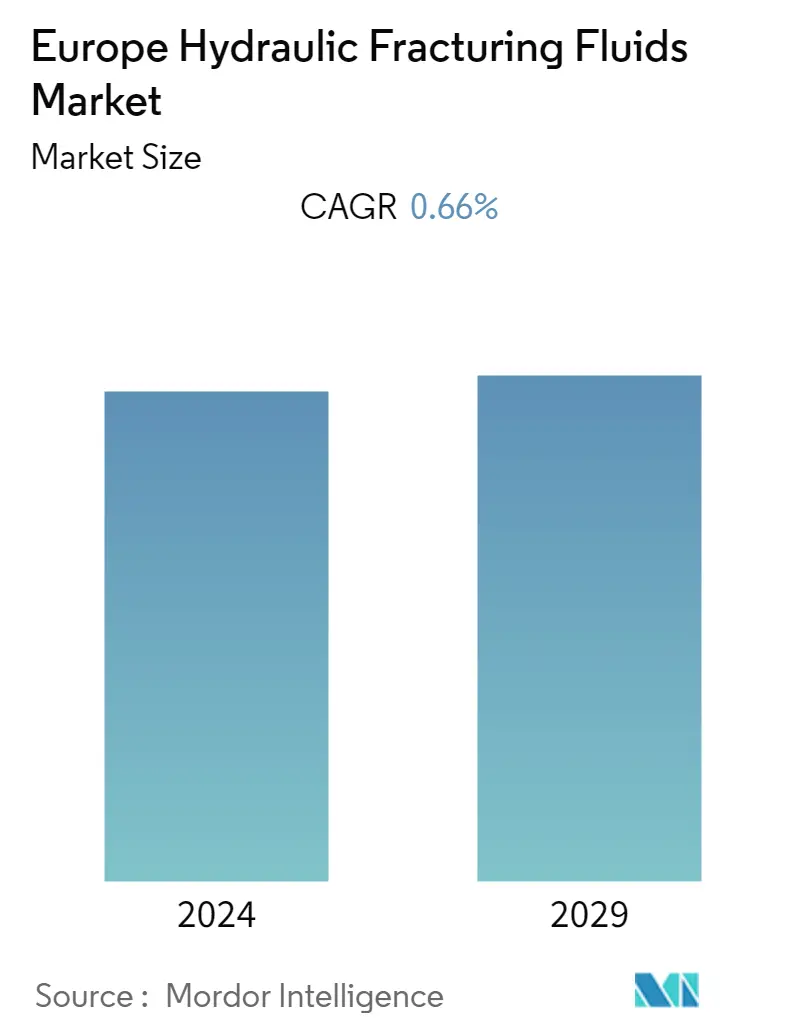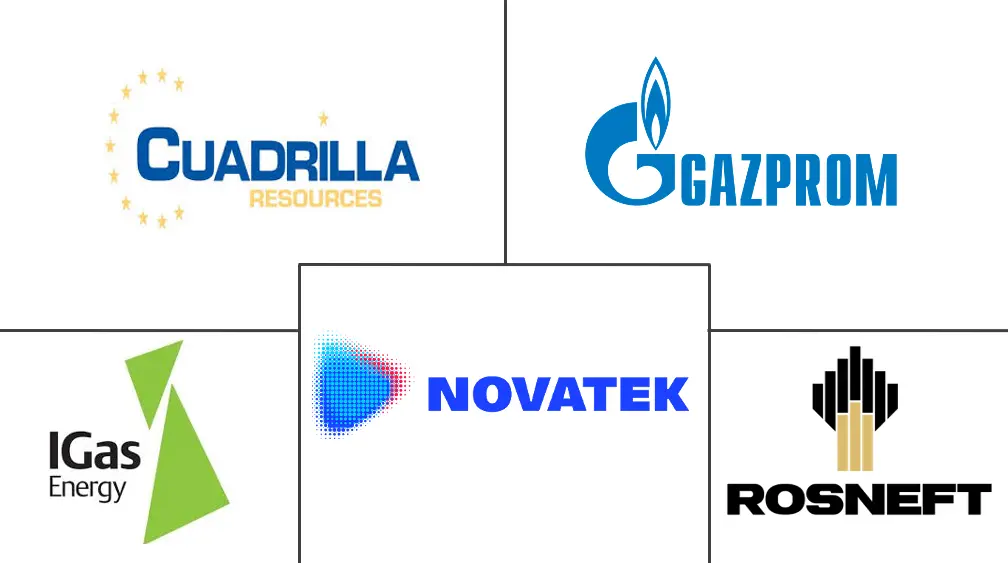Market Size of Europe Hydraulic Fracturing Fluids Industry

| Study Period | 2021 - 2029 |
| Base Year For Estimation | 2023 |
| Forecast Data Period | 2024 - 2029 |
| Historical Data Period | 2021 - 2022 |
| CAGR | 0.66 % |
Major Players
*Disclaimer: Major Players sorted in no particular order |
Europe Hydraulic Fracturing Fluids Market Analysis
The European hydraulic fracturing fluids market is expected to record a CAGR of more than 0.66% during the forecast period.
The market was negatively impacted by COVID-19 in 2020. Presently, the market has reached pre-pandemic levels.
- Over the long term, the increasing demand for oil and gas and the countries trying to reduce their dependence on imports have been boosting the growth in the sector.
- On the other hand, the impact of hydraulic fracturing on the environment and technological constraints have impeded the growth in the industry. Many countries, including the Netherlands and Ireland, have banned the process of hydraulic fracturing, which also caused concerns in the hydraulic fracturing market.
- The pipeline being built through the Baltic Sea is expected to add to the demand for Russian gas. An increase in demand may lead companies to invest in unconventional resources, which can become an opportunity for companies in the oil and gas industry.
- Russia is expected to dominate the market over the forecast period due to the presence of economically feasible shale reserves in the country.
Europe Hydraulic Fracturing Fluids Industry Segmentation
Hydraulic fluid fracturing has been used by the oil and gas industry to boost hydrocarbon production since 1947. It is a process in which a special fluid is injected into a wellbore to induce fractures and facilitate access to oil and gas.
The European hydraulic fracturing fluids market is segmented by resource type, fluid type, well type, and geography. By resource type, the market is segmented by oil and natural gas. By fluid type, the market is segmented by slick water-based fluid, foam-based fluid, gelled oil-based fluid, and other base fluids. By well type, the market is segmented by horizontal and verical wells. The report also covers the market size and forecasts for the market across the major countries. For each segment, the market size and forecasts have been done in USD billion.
| Resource Type | |
| Oil | |
| Natural Gas |
| Fluid Type | |
| Slick Water-based Fluid | |
| Foam-based Fluid | |
| Gelled Oil-based Fluid | |
| Other Fluid Types |
| Well Type | |
| Horizontal | |
| Vertical |
| Geography | |
| United Kingdom | |
| Russia | |
| Norway | |
| Rest of Europe |
Europe Hydraulic Fracturing Fluids Market Size Summary
The European hydraulic fracturing fluids market is poised for moderate growth, driven by increasing demand for oil and gas as countries seek to reduce import dependence. Despite the initial setbacks due to the COVID-19 pandemic, the market has rebounded to pre-pandemic levels. However, environmental concerns and technological challenges have hindered growth, with countries like the Netherlands and Ireland banning hydraulic fracturing. Russia is expected to play a dominant role in the market, leveraging its economically viable shale reserves. The construction of pipelines, such as the one through the Baltic Sea, is anticipated to boost demand for Russian gas, encouraging investments in unconventional resources.
Natural gas is projected to see a significant rise in demand, supported by new projects in natural gas-powered plants, LNG bunkering, and district heating. The United Kingdom, Russia, and Poland are the primary countries where hydraulic fracturing is expected to be utilized, although each faces its own set of challenges. The approval of new oil and gas fields in the North Sea by the UK government is expected to bolster the market. Russia's expansive shale oil and gas reserves, particularly the Bazhenov Shale, are set to drive market growth, with plans to enhance LNG capacity to compete globally. The market remains moderately fragmented, with key players including Cuadrilla Resources Ltd, PJSC Rosneft Oil Company, and Gazprom, among others, actively pursuing opportunities in the sector.
Europe Hydraulic Fracturing Fluids Market Size - Table of Contents
-
1. MARKET OVERVIEW
-
1.1 Introduction
-
1.2 Market Size and Demand Forecast in USD billion, Until 2027
-
1.3 Recent Trends and Developments
-
1.4 Government Policies and Regulations
-
1.5 Market Dynamics
-
1.5.1 Drivers
-
1.5.2 Restraints
-
-
1.6 Supply Chain Analysis
-
1.7 Porter's Five Forces Analysis
-
1.7.1 Bargaining Power of Suppliers
-
1.7.2 Bargaining Power of Consumers
-
1.7.3 Threat of New Entrants
-
1.7.4 Threat of Substitutes Products and Services
-
1.7.5 Intensity of Competitive Rivalry
-
-
-
2. MARKET SEGMENTATION
-
2.1 Resource Type
-
2.1.1 Oil
-
2.1.2 Natural Gas
-
-
2.2 Fluid Type
-
2.2.1 Slick Water-based Fluid
-
2.2.2 Foam-based Fluid
-
2.2.3 Gelled Oil-based Fluid
-
2.2.4 Other Fluid Types
-
-
2.3 Well Type
-
2.3.1 Horizontal
-
2.3.2 Vertical
-
-
2.4 Geography
-
2.4.1 United Kingdom
-
2.4.2 Russia
-
2.4.3 Norway
-
2.4.4 Rest of Europe
-
-
Europe Hydraulic Fracturing Fluids Market Size FAQs
What is the current Europe Hydraulic Fracturing Fluids Market size?
The Europe Hydraulic Fracturing Fluids Market is projected to register a CAGR of 0.66% during the forecast period (2024-2029)
Who are the key players in Europe Hydraulic Fracturing Fluids Market?
Cuadrilla Resources Ltd. , PJSC Rosneft Oil Company , PJSC Gazprom , PAO NOVATEK and IGas Energy Plc are the major companies operating in the Europe Hydraulic Fracturing Fluids Market.

